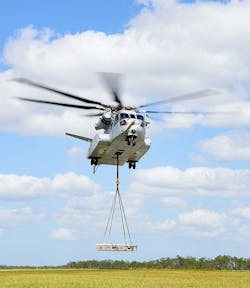Sikorsky CH-53K King Stallion heavy-lift helicopter achieves first flight with external load
WEST PALM BEACH, Fla., 28 April 2016. The Sikorsky CH-53K helicopter has achieved its first external lift flight while carrying a 12,000-pound external load at Sikorsky's Development Flight Test Center in West Palm Beach, Florida, Lockheed Martin (NYSE:LMT) officials reveal.
"Our flight envelope expansion efforts remain on track, and we continue to make good progress toward our initial operational test assessment later this year, and ultimately full aircraft system qualification," says Mike Torok, Sikorsky's vice president of CH-53K programs.
The first two CH-53K heavy-lift helicopters achieved their first flights on 27 October 2015 and 22 January 2016, respectively. To date, these helicopters have achieved over 50 flight hours combined, including one flight at speeds over 140 knots. The third and fourth King Stallion aircraft will join the flight test program this summer.
As the King Stallion flight test program proceeds, both of the current flying aircraft will be exercised to expand the external load envelope. Initial external payloads weighing 12,000 pounds will be flown first in hover and then incrementally to speeds up to 120 knots. The aircraft will then carry 20,000- and 27,000-pound external payloads.
The CH-53K King Stallion is equipped with single, dual, and triple external cargo hook capability that will allow for the transfer of three independent external loads to three separate landing zones in support of distributed operations in one single sortie without having to return to a ship or other logistical hub. The three external cargo hooks include a single center point hook with a 36,000 lb. capability and dual-point hooks each capable of carrying up to 25,200 pounds. The system features an electrical load release capability from the cockpit and cabin, and a mechanical load release capability at each of the pendant locations. An auto-jettison system is incorporated to protect the aircraft in the event of a load attachment point failure.
"It is exciting to have achieved our first external lift, another important step towards fielding the most powerful U.S. military helicopter," says Col. Hank Vanderborght, U.S. Marine Corps program manager for heavy lift helicopters. "Our program continues on pace to deploy this incredible heavy lift capability to our warfighters."
Sikorsky Aircraft, a Lockheed Martin company, is developing the CH-53K King Stallion heavy-lift helicopter for the U.S. Marine Corps. The King Stallion maintains similar physical dimensions and "footprint" as its predecessor, the three-engine CH-53E SUPER STALLION helicopter, but will more than triple the payload to 27,000 pounds over 110 nautical miles under "high hot" ambient conditions.
Features of the CH-53K helicopter include a modern glass cockpit; fly-by-wire flight controls; fourth-generation rotor blades with anhedral tips; a low maintenance elastomeric rotor head; upgraded engines; a locking, United States Air Force pallet compatible cargo rail system; external cargo handling improvements; survivability enhancements; and improved reliability, maintainability and supportability.
The U.S. Department of Defense's Program of Record remains at 200 CH-53K aircraft. The Marine Corps intends to stand up eight active duty squadrons, one training squadron, and one reserve squadron to support operational requirements.
You might also like:
Subscribe today to receive all the latest aerospace technology and engineering news, delivered directly to your e-mail inbox twice a week (Tuesdays and Thursdays). Sign upfor your free subscription to the Intelligent Inbox e-newsletter at http://www.intelligent-aerospace.com/subscribe.html.
Connect with Intelligent Aerospace on social media: Twitter (@IntelligentAero), LinkedIn,Google+, and Instagram.
Intelligent Aerospace
Global Aerospace Technology NetworkIntelligent Aerospace, the global aerospace technology network, reports on the latest tools, technologies, and trends of vital importance to aerospace professionals involved in air traffic control, airport operations, satellites and space, and commercial and military avionics on fixed-wing, rotor-wing, and unmanned aircraft throughout the world.

Courtney E. Howard | Chief Editor, Intelligent Aerospace
Courtney enjoys writing about all things high-tech in PennWell’s burgeoning Aerospace and Defense Group, which encompasses Intelligent Aerospace and Military & Aerospace Electronics. She’s also a self-proclaimed social-media maven, mil-aero nerd, and avid avionics and space geek. Connect with Courtney at [email protected], @coho on Twitter, on LinkedIn, and on Google+.


